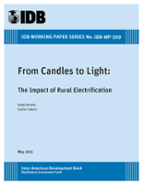From Candles to Light: The Impact of Rural Electrification
Date
May 2015
This paper studies the impact of access to electricity via solar-powered home systems (SHSs) in rural communities in Peru. Applying propensity score matching at the community as well as at the household level, the authors find that households with SHSs spend less on traditional sources of energy---candles and batteries for flashlights---and that the subsequent savings are commensurate to the fee for SHS use. People in households with SHSs spend more time awake, and women in particular change patterns of time use: they spend more time taking care of children, cooking, doing laundry, and weaving for their families, and less time in productive activities outside their homes (farming). Children spend more time doing homework, which has translated into more years of schooling (among elementary school students) and higher rates of enrollment (in secondary school). Although women spend less time farming and men more time on home business activities in households with SHSs than in those without, these changes have had no evident impact on income or poverty.



